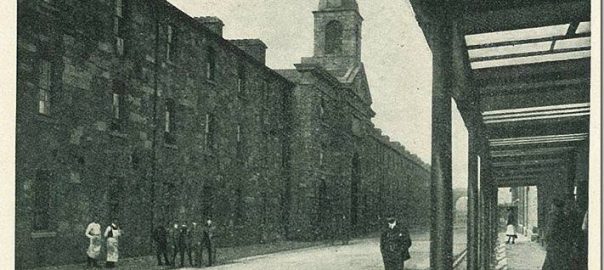Richmond Barracks – within whose walls over 3,000 Irish rebels were held – has been carefully restored. It is no longer a museum but has become a cultural centre, where community workshops and artistic events take place.
If one sees the saga of Easter Week 1916 as a drama, the first Act is centred on the GPO and the last Act focuses on the the executions in Kilmainham Gaol. But the middle Act was played out in Richmond Barracks. Over 3,000 rebels, men and women of the Easter Rising, were held and sorted in the barracks buildings. The front line soldiers, rounded up from across Ireland, were packed in tightly, awaiting their sentence to prison camps in England or Wales.
The leaders were plucked out of the crowd and set aside in the barracks gymnasium to await their courts martial and fate. 90 death sentences were handed out over the first two weeks of May, and 14 executions were carried out in Kilmainham, including the seven signatories of the proclamation. Many of the architects of the new Irish state were held in the barracks including Michael Collins, Eamon De Valera, Arthur Griffith, and William T. Cosgrave.
Even the conclusion to the Rising has its roots in the Richmond Barracks. The British Prime Minister, Herbert Asquith, visited Richmond Barracks on the 13th of May, and the stay of executions which followed is often attributed to that visit.
In time, Richmond Barracks was given over by the State to to house people who required accommodation. By 1926, the converted barracks were renamed Keogh (or Kehoe) Square. By 1928, 248 families were housed in the barracks buildings and an additional 218 families lived in houses built on the thirteen acre field east of the square.
When the barracks were first converted into flats, they were amongst the finest in Dublin. Each hall housed six families, two on each floor, and each flat usually had two or three bedrooms, a large living room and open fire, a small kitchen, and a toilet. The estate was working class, with some people struggling to get by on small or no wages while feeding large families. It was a strong and stable community with close ties to one another. The site subsequently became a school, a museum and is now a cultural centre.
The adjacent Goldenbridge Cemetery is now open to visitors for the first time since it closed in 1869. This was the first Catholic cemetery in Ireland, founded by Daniel O’Connell in 1828. Visitors can walk through the unspoilt garden cemetery; learn about the vaults, the watchmen with guard dogs, and bodysnatching; and visit a Taoiseach’s grave and that of an eight year old boy killed as a result of a bullet wound in the 1916 Rising.
Walking Tour: Richmond Barracks to Kilmainham – Walk in the footsteps of the leaders of the 1916 Easter Rising, from Richmond Barracks to Kilmainham Gaol. Hear the story of Inchicore, from the Rising’s ‘lost chapter’, to ‘the Saints’ Football Club, and the art deco Inchicore Library. This guided walk will take you right through the heart of historic Inchicore and Kilmainham.
Goldenbridge Cemetery Tour – Experience the atmospheric surrounds of Ireland’s first garden cemetery, founded by Daniel O’Connell almost 200 years ago.
There is also an extensive programme of free talks and classes.
Opening Hours:
Mon to Sat, 10am – 5pm; only the library is open on Mondays.
Closed Sundays and Bank Holidays.
Kilmainham Walking Tour runs Thursdays and Saturdays at 11am.
Goldenbridge Cemetery Tour runs Thursdays and Saturdays at 1pm.
Further details and other events can be found here.
Contact & Pricing:
richmondbarracks.ie
[email protected]
Tel: 01 524 2532
Off Bulfin Rd, Inchicore, Dublin 8
Adults €10 per tour; concessions
